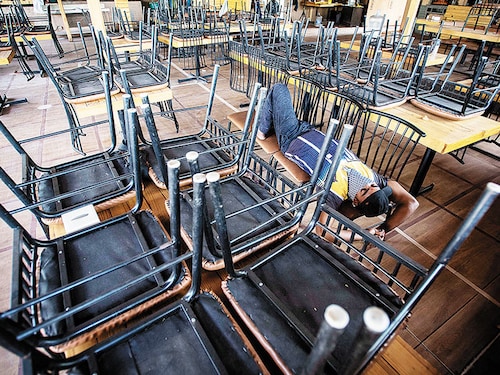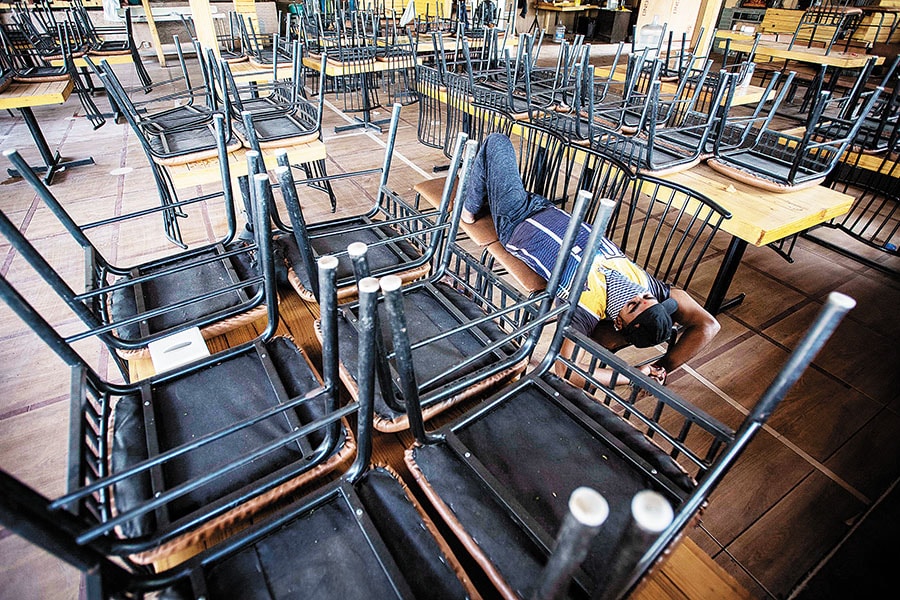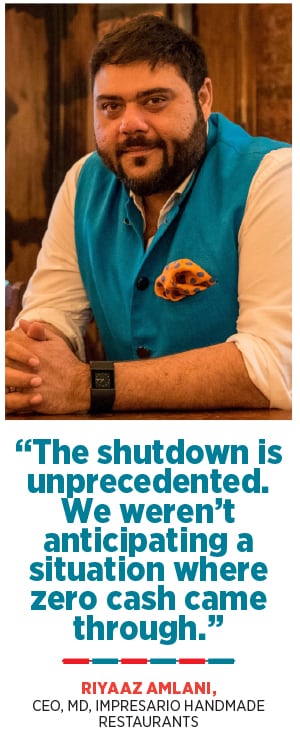Covid-19 lockdown: Does the F&B industry need to rethink its business models?
The coronavirus outbreak has spelt disaster for the industry—already running on wafer-thin margins—as fears of restaurants shutting down and mass layoffs loom large


 A worker sleeps inside a shut restaurant in Pune. Following the announcement of a 21-day national lockdown, restaurants across the country are faced with fixed costs, while revenues have dwindled to nothing
A worker sleeps inside a shut restaurant in Pune. Following the announcement of a 21-day national lockdown, restaurants across the country are faced with fixed costs, while revenues have dwindled to nothing
Image: Pratham Gokhale/Hindustan Times via Getty Images
Anurag Katriar, executive director and CEO of deGustibus Hospitality, remembers March 11, the day after Holi, rather well. That day Mumbai recorded its first Covid-19 case and his restaurants—Indigo Deli, Indigo Burger Project, Neel, D:OH, among others—began to see a dip in footfall. By the time Katriar, also president of the National Restaurant Association of India (NRAI), which represents 500,000-plus F&B outlets, sent an advisory to its members on March 17, asking them to down shutters, his business had fallen by over 50 percent. “I had thought Covid-19 wouldn’t impact India the way it has. I made a mistake,” says Katriar, who owns 13 brick-and-mortar outlets, 11 delivery kitchens and a catering arm.
Holi 2020 has been a watershed moment for several other big guns of the F&B industry too. Impresario Handmade Restaurants, which has in its stable hangouts like Social and Smokehouse Deli, lost 20 percent of its clients after the festival and 40 percent by the weekend that followed. For the Olive Group, the umbrella company for restaurants like Olive Bar and Kitchen, Monkey Bar, The Fatty Bao, SodaBottleOpenerWala, the loss of business began with tour groups, parties and group bookings being cancelled. When the outbreak reached India, it also stopped bar nights of all kinds: That hurt the balance sheets big time, says AD Singh, chairman. Then, as individual states announced lockdowns and eventually the national was declared on March 25, all of Olive Group’s 37 restaurants and delivery kitchens across eight brands and six cities shut down.
“The shutdown is unprecedented. We did have some situations where single outlets were shut down earlier, but we never really thought there would be a scenario where every single outlet would be closed, and zero cash coming through the system,” says Riyaaz Amlani, CEO & MD of Impresario, which has 59 outlets across the country.
The economic repercussions of Covid-19 are worrying entrepreneurs as much as its impact on public health is. And they’re set to sting the F&B industry, which, at 7.3 million, provides the highest employment after agriculture—one-third of which is in organised restaurants.
India’s food services industry, currently estimated at $60 billion, is bigger than sectors such as railways, FMCG and consumer durables, among others. Till before the coronavirus shutdown, it was projected to grow at a CAGR of 9 percent and reach $100 billion within five years, says Saloni Nangia, president, Technopak, a management consulting firm. With its operating cash flow usually sourced from incoming revenues, the shutdown is likely to dry up its resources and the ensuing liquidity crunch “could be extreme”, adds Nangia, threatening survival for some.
“Over the long term, we are going to see the wiping out of many, many restaurants. Restaurants that have institutional funding or PE funding, that have been in operation for long and have reserves, will manage to sustain themselves for a couple of months. But most standalone, single restaurant operators don’t have cash flows for more than two or three weeks. It’s fine to say we are deferring all statutory payment deadlines, but it won’t help much. It will take many, many months post the termination of this pandemic to come back to the pre-pandemic levels of business,” says Rahul Akerkar, founder and managing partner of Qualia Hospitality.Akerkar is struggling to pay employees of his barely-year-old restaurant Qualia, in Mumbai’s Lower Parel, as is deGustibus. The Olive Group was among the earliest to shut down to let employees return to their hometowns to be with their families without any revenues or reserves, the group, like most others, was battling low funds. Amlani is not planning to rationalise salaries yet but admitted his pockets don’t run deep either. “My immediate challenge is cash flow. At the moment, most Impresario restaurants only have enough to pay half a month"s salary to staff, not enough for rent or taxes. With 3,500 employees depending on me for their salaries, I do have reasons to worry,” he says.
On March 21, NRAI wrote a letter to Finance Minister Nirmala Sitharaman, requesting for an immediate deferment of statutory dues and utility bills, moratorium of repayment of loans and facilities, restoration of input tax credit on GST, unemployment pay cover for employees and a notification allowing invoking of force majeure, which protects a party from failure to perform contractual obligations in situations on which it has no control.
About a week later, the Reserve Bank of India rolled out a slew of initiatives that deferred payment of loan instalments by three months, among others. Katriar says this will help him pay a restructured salary of 60 to 70 percent to his employees for some time. Akerkar lauds the move as a start, but says: “There is a lot more that we need to do.”
*****
The restaurant industry is more vulnerable than several other sectors. “About 81 percent of restaurants in the organised sector don’t last for more than 30 months. I don’t think any other sector has this kind of a mortality rate,” says Katriar. While groceries constitute essential retail, eating out is discretionary. As sentiments and customer confidence dip, it will not only slow down the number of people coming to F&B establishments, but also the volume of spending. “This impact would last through Q1, and even for some months of Q2,” says Nangia of Technopak.
Besides, high fixed costs—salaries, rentals, utilities etc—are a ticking time bomb. For a company like deGustibus, such recurrent expenses constitute almost 60 percent of its topline, while Impresario spends about 17 to 18 percent on wages, and 15 percent on rent. It’s commonly said that with the disproportionate rentals it demands, the restaurant business is actually a real estate business.
Most of the F&B companies work on a combination of debt and equity and the accruals they get from their business. During the boom years of F&B, through the greater part of the past decade, many large players picked up debt and planned to service it with their profits. The first hitch came in November 2017, in the form of removal of input tax credit for GST. It meant shaving off about 4 to 5 percent of the topline in an industry where even a top dog gets to play around with a wafer-thin 20 percent Ebitda margin. “Because of the high proportion of fixed costs, Ebitda can become negative if the topline dives by 15-20 percent,” says Katriar.
With the Covid-19 impact indeed bringing topline to zero (or negative, as restaurants have to keep paying for services like storage, security etc), it has compounded the industry’s woes. “If I had a full-fledged restaurant today, I would be hitting my head against the wall,” says Saransh Goila, founder of Goila Butter Chicken, who runs four takeaway joints in Mumbai. “I have told my 35 staffers that if they stick around, we will pay them half salaries till end of April. At the end of it, we might have to shut shop and restart when things are okay.”
Singh of Olive is no stranger to closure of restaurants. The Olive Bar and Kitchen in Delhi’s Mehrauli area was shut down in 2006 as part of a citywide sealing drive. “When we reopened, we had to work on all aspects, from menu to marketing, from scratch, because the habits of our regulars had changed. Eventually, in terms of numbers, we surpassed what we were doing earlier, but the connect and quality of the crowd that we had earlier had dissipated. Now, we’ll have to rebuild the entire ethos and habit of dining out,” he says.
When Olive Delhi was shut, Singh claims he had paid his staff their full salaries and benefits till the group was able to reopen at Malcha Marg in October 2007. But a difficult few years leading up to the Covid-19 crisis has tied his hands this time. “The last three years have wiped out our reserves. I have waived my salary from the day we shut. Please understand that we are not unwilling to pay salaries, simply unable. How many of us can reopen depends on the steps taken by the government to back us,” says Singh.
*****While the lockdown has downed the shutters of restaurants, it hasn’t amped up the delivery business either, despite the home ministry making exemptions for suppliers of essential goods, including restaurants home-delivering food. The police cracked down on delivery services and restaurants, which halted operations in response. Goila Butter Chicken was open till March 24, but after one of its chefs was beaten up on his way to work, it closed all outlets. So did Olive Pizzeria, a delivery-only brand for the Olive Group, which stopped functioning as its staff weren’t able to get to work.
Even when Goila’s outlets were open through the second and third weeks of March, there was just a marginal spike in business, “but because delivery partners were operating haphazardly, I wouldn’t call it a substantial increase,” he says. “I can’t say business was great.”
Swiggy and Zomato, India’s largest food delivery and ordering platforms, declined interview requests by Forbes India, so did Jubilant Foodworks, which had suspended dine-in services at its Domino’s outlets since March 24. Rebel Foods, which runs cloud kitchens like Faasos, Behrouz Biryani and Oven Story Pizza, among others, admitted to a decrease in business in tier-1 cities.
It’s a similar story at Ghost Kitchens, where founder and food services entrepreneur Karan Tanna operates 18 cloud kitchen brands from 22 locations in four cities. “Since private companies were closed, our corporate delivery came down to zero, which a slight rise in volume in some residential pockets couldn’t make up for. Also, since a lot of housing societies were not allowing riders inside, it discouraged people from ordering. My business saw a 15 to 20 percent dip,” says Tanna, who shut operations from March 22, keeping in mind the safety of his employees.
For diners staying away from food delivery, the fear of contamination in the supply chain looms large. Says Mohini Chaudhuri, a journalist from Mumbai, “I feel scared to even order online. I keep wondering how many hands the food has passed through, did they wear gloves, were people wearing masks, was anyone sick... even when this is over, these fears will take a while to subside.”
While fear may put a leash on footfalls in the initial days after the lockdown is eased, a hike in prices to make up for the lost months may keep people away from restaurants in the long run. Mustafa Sethwala, director at Sethwala Foods Ltd, which supplies chicken to five star restaurants at the Marriott and Taj hotels and restaurants such as Barbeque Nation and Mainland China across Mumbai and Pune, expects scarcity to push up prices in the coming months. At present, chicken farmers earn ₹30 per live bird, compared to an average price of ₹75 throughout the year. “The average cost of production in our industry is ₹65. If you earn ₹30, you are at a 50 percent loss to break even. Typically, in such cases, farmers don’t have enough money to buy the next set of birds. That causes scarcity and may send the price through the roof once things normalise,” says Sethwala.
If such inflation is passed on to diners, fewer are expected to eat out. “This period is going to leave us all with broken bank accounts. Many in my family are dealing with pay cuts and the prospect of no salary too. So extravagant meals may not be possible once this is over,” says Chaudhuri.
Going ahead, Amlani expects business to be at 80 percent of last year. Many feel the restaurant industry needs to reorient its business model—convert the fixed costs to variables perhaps and move into the revenue share model. “We need to get into asset-light, low-risk ventures. Plus, we need higher entry barriers. People with no experience think they can change the industry by hiring someone who draws ₹1-2 lakh in salary and change the rules of the game,” says Katriar.
Bottom line: The restaurants will have to undercut a lot of costs, be it slashing marketing budgets, rationalising the workforce, putting brakes on expansion plans and even renegotiating commissions with delivery platforms that currently stand at around 20 percent.
“It’s the first industry to go down and the last to rise up,” says Tanna as his breed and he prepare to grit it out on the long road to recovery.
First Published: Apr 03, 2020, 11:40
Subscribe Now

